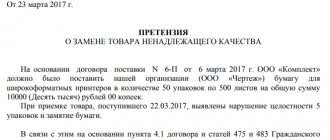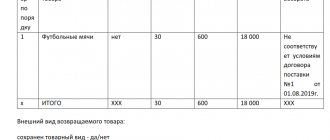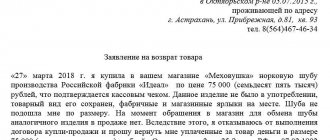Home / Complaints, courts, consumer rights / Consumer rights
Back
Published: 08/31/2018
Reading time: 8 min
0
1064
According to the legislation of the Russian Federation, the buyer has the right to return non-food products of inadequate quality under warranty for repair, exchange, refund, recalculation of cost, or receipt of certain compensation. At the same time, satisfaction of such requirements is possible only in cases where it is proven that the buyer was not involved in the occurrence of the defect that caused the return.
- Examination of goods of inadequate quality: concept, legal regulation, goals of the procedure
- Objectives of the examination
- Characteristics of the procedure
- Features and results of the procedure
- The procedure for conducting an examination of the quality of goods Presentation of goods
- Compiling and submitting an application
- Appointment of examination
- Expertise
- results
To establish the causes of the deficiency, as well as resolve other possible disputes in such situations, the legislation provides for the possibility of conducting an examination of the quality of the product.
Examination of goods of inadequate quality: concept, legal regulation, goals of the procedure
The rights and obligations of the parties arising from the purchase and sale of various goods (in this case, non-food durable goods) are regulated by the provisions of the Law of the Russian Federation No. 2300-1 “On the Protection of Consumer Rights” (hereinafter referred to as Law No. 2300-1), as well as a number of other regulatory legal acts.
According to Art. 18 of the said law, the seller (or other responsible party) is obliged to accept goods of inadequate quality from the buyer for replacement with an identical or similar one, free repair, recalculation of the cost or refund of money in accordance with the warranty conditions agreed upon at the time of purchase and fixed in the sales contract .
According to paragraph 5 of this article, the seller, if necessary, can check the quality of the goods on site in the presence of the buyer. In case of doubt or dispute regarding the occurrence of a defect that caused a return, the seller is obliged to initiate a technical examination of the quality of the product.
Quality examination in the context under consideration is a set of technical procedures carried out by a third party to check the serviceability, quality and compliance of a particular product of a certain brand, model and article with the declared parameters and characteristics. The initiator of the examination can be either the seller, the buyer, or another interested party.
State examination: what is it?
This is the name of a study that is carried out in one of the state forensic institutions.
In the majority (according to some estimates, up to 70% of examinations) of cases, courts entrust research to state forensic institutions.
State experts mainly conduct: forensic, medical-social, forensic-psychiatric, psychological-psychiatric, molecular-genetic, fire-technical examinations.
In Russia there is an extensive system of state forensic institutions:
- forensic units of the Ministry of Internal Affairs of Russia - the largest expert service in the country;
- forensic institutions of the Ministry of Justice;
- forensic and forensic psychiatric institutions of the Ministry of Health and Human Services;
- Department of Defense forensic laboratories;
- forensic units of the Federal Security Service;
- forensic institutions of the Federal Customs Service;
- State fire-technical laboratories of the Ministry of Emergency Situations.
Objectives of the examination
The immediate objectives of the examination are:
- determination of the overall quality of the presented goods , as well as the nature of the existing shortcomings regarding the possibility of its full intended use;
- identifying the causes of existing deficiencies: establishing the presence of a manufacturing defect or violation of the rules of operation, transportation, storage, etc.
It is on the basis of the results of the study that the responsible party draws a conclusion about the causes of the malfunction and makes a decision on the possibility or impossibility of satisfying the buyer’s claim in accordance with legal requirements.
Characteristics of the procedure
The examination of product quality is carried out by a third party, i.e., an independent public or private organization capable of providing unbiased and objective research results. Such an organization must have the appropriate authority (accreditation and a valid license), as well as the necessary resources - equipment, qualified personnel, etc.
In accordance with paragraph 5 of Art. 18 of Law No. 2300-1, examination of the quality of goods is carried out at the expense of the seller or other responsible party.
However, if the initiator of the examination is the buyer, the procedure is carried out at his expense.
Who pays for the examination
If a defect is discovered within the warranty period, the seller pays for the examination of the goods. But if it turns out that defects in the product arose due to the fault of the buyer, he will be obliged to compensate the seller for the cost of the examination. And in addition - the costs of storing and transporting goods.
Keep all documents related to the examination. They will be needed if the store collects expenses from the buyer.
If a defect is discovered after the expiration of the warranty period, but within two years from the date of sale of the goods, then the buyer pays for the examination. If the examination shows that the defect arose before the sale of the goods, that is, the defect is manufacturing, the seller will have to compensate the buyer for the cost of the examination - clause 5 of Art. 19 of the Law on Consumer Rights.
If the seller does not satisfy the buyer's demands, he can go to court, and he will collect much more from the store.
A woman bought leather shoes in a store and later discovered that the sole of the right one had become unstuck. The warranty period had expired at the time the defect was discovered.
The buyer applied to the store for a refund for the shoes, but was refused. She conducted an independent examination, which showed that the defect was of a manufacturing nature.
The woman again filed a claim with the store for a refund of the cost of the shoes and reimbursement of the cost of the examination, but did not receive a response, so she went to court.
The court agreed with the conclusions of the examination and recovered from the store:
- the cost of the shoes is 43,950 ₽,
- expenses for the examination 5,000 ₽,
- penalty 25,000 ₽,
- expenses for paying for the services of a representative 5,000 ₽,
- postage costs 1,230 ₽,
- costs for copying services 470 ₽,
- expenses for notary services 2,040 ₽,
- compensation for moral damage 1,000 ₽,
- fine 20,000 ₽;
- state duty 2,568.5 ₽.
So, instead of 48,950 rubles, which the customer asked to reimburse in the claim, the store had to pay 106,258.5 rubles.
Case No. 2-9698/2017 (16)
Features and results of the procedure
The product quality examination itself is carried out in several stages (with special attention paid to the defect that caused the return):
- Functional Test: The product is tested to ensure that it meets the specifications and functions stated by the manufacturer and/or seller.
- External inspection: the product is examined for the safety of seals, the presence of any external damage, deformation or other defects.
- Internal inspection: the internal structure of the product is checked for compliance with technical documentation, the presence of any damage, as well as traces of contamination and contact with liquids.
Based on the inspection, the experts draw up a corresponding written conclusion on the reasons for the defect, i.e., they actually confirm or deny the buyer’s involvement in the defect he identified.
The procedure for examining the quality of goods
The procedure for examining a defective product consists of the following stages:
- Presentation of goods of inadequate quality.
- Drawing up a return application.
- Appointment of examination.
- Direct examination.
- Obtaining examination results.
Presentation of goods
Products with identified defects are presented to representatives of the selling organization or other responsible party along with documents confirming the fact of purchase. After the buyer identifies any detected defects, authorized persons conduct an initial inspection of the goods on site.
Compiling and submitting an application
In addition to the goods and supporting documents, you must also present a corresponding application.
The text of the document indicates:
- addressee: name and head of the organization accepting the goods under warranty;
- applicant: full name, address and contact details of the buyer;
- description: date and place of purchase, nature of defects or inconsistencies found;
- the essence of the claim in accordance with legal requirements: return, exchange, recalculation, etc.;
- consent to conduct technical examination;
- applicant's signature and date of filing.
The application is drawn up in two copies. One is handed over to the authorized representative of the party responsible for the warranty obligations; on the second, the employee of the receiving party puts a mark on acceptance of the claim (signature, date, seal) and returns it to the buyer.
Appointment of examination
The examination of the presented goods is initiated by the receiving party if it is impossible to identify the cause of the malfunction on site.
According to legal requirements, the buyer must be notified in advance of the place and time of this event and has the right to be present at each stage.
Expertise
During the procedure, employees of the expert organization draw up a corresponding report, copies of which, upon completion of the product examination, are handed over to representatives of interested parties. The text of this document must contain:
- description of the accepted product: brand, model, article number, technical characteristics and parameters;
- information about responsible employees of the expert organization: full name and position;
- a detailed description of each stage of verification: serviceability of the product, its compliance with the declared functions and characteristics, safety of seals, the presence of any external and/or internal defects, etc.;
- comments and signatures of all participants in the procedure: experts, the buyer, as well as other persons whose presence at such events does not contradict the law;
- time and date of the procedure.
Any violations committed by experts during the procedure must be recorded in the “Comments” column, after which this document can be used as evidence of unlawful actions against the buyer in the event of subsequent legal proceedings.
results
Based on the results of the procedure, employees of the expert organization draw up a written conclusion, copies of which are also transferred to interested parties.
The text of the conclusion contains:
- data of the party that initiated the examination;
- date and time of the examination performed;
- information about the tested product;
- assessment and conclusions: expert opinion on the nature of the product deficiency, the probable causes of its occurrence, as well as its impact on the possibility of full-fledged intended use of the product.
Upon receipt of the expert opinion, the party responsible for warranty service makes a decision on the advisability of satisfying the claim received from the buyer.
In cases where the results of a product inspection indicate direct or indirect involvement of the buyer in the occurrence of a defect, he (the buyer) undertakes to reimburse the seller (or another party that initiated the examination) for all direct and associated costs of its implementation. In this case, the claims made by the buyer regarding the quality of the purchased goods lose their legal force.
In the same case, if the buyer does not agree with the results of the examination, he has the right to carry out a similar procedure independently by contacting another organization of the appropriate profile at his own expense. At the same time, representatives of the receiving party must also be notified of the place and time of the procedure.
Features of the product examination report
If you need to draw up a certificate of examination of goods, and you have never done this before, look at the example below and read our recommendations - taking them into account, you can easily generate the necessary document.
Before proceeding to a detailed description of the act, we will give some general information.
- The act can be written in free form or, if the organization has a document template, according to its type. You can fill it out manually or type it on a computer (with mandatory subsequent printing). In this case, for an expert opinion, either a simple blank sheet of paper of any convenient format (preferably A4 or A5) or a letterhead will be suitable.
- The act must certainly be signed personally by the person who conducted the examination, as well as by the persons present at it (if there were any acts). The document must be stamped.
- The act is drawn up in at least two copies identical in content and equivalent from a legal point of view. One of them remains with the expert, the second is transferred to the interested party. If there is a need, you can make additional copies of the act, having them properly certified.
Timing of the examination
In accordance with the provisions of Law No. 2300-1, the maximum permissible total period for carrying out all stages of the examination depends entirely on the nature of the claim made by the buyer on the basis of the guarantee.
The maximum period allotted for the examination is, by default, included in the period allotted by law for satisfying a specific claim.
In particular, according to the above law, the maximum permissible period for conducting an examination (depending on the specific claim) is:
- Clause 1 Art. 20: elimination of deficiencies – 45 days from receipt of the complaint. Depending on the circumstances, this period may be extended by mutual agreement of the parties.
- Clause 1 Art. 21: replacement of goods with an identical or similar one – 20 days. However, if a replacement product is not available, this period is 30 days from the date of receipt of the claim.
- Art. 22: cancellation of the purchase and sale transaction, recalculation of cost, compensation for losses - 10 days from the date of receipt of the claim.
Time limits for the examination of products whose quality does not correspond to the declared one
After discovering defects in the product, you need to contact the seller, or directly to the manufacturer of the product with a list of general requirements. You can replace the product or eliminate its shortcomings. In case of any disputes, the seller must carry out the assessment procedure at his own expense.
Previously, the timing of such operations was not established by law, but recently everything has changed. Now the examination is carried out in accordance with Articles 20, 21 and 22. The period for carrying out this operation also includes certain requirements. If you wish, you can conduct an examination or not conduct it; everything will depend only on you.
The duration of the meeting directly depends on the requirements of each party. A period of 45 days is established and during this time period it is necessary to eliminate defects in the product, and within 20 days the product must be replaced with a new one. You can reduce the cost of a product within 10 days; to do this, you will only need to put forward a number of requirements.
A special rule is also being introduced, according to which each client has the right to re-examine the product if for some reason he does not agree with the previous assessment. This is done in court.







